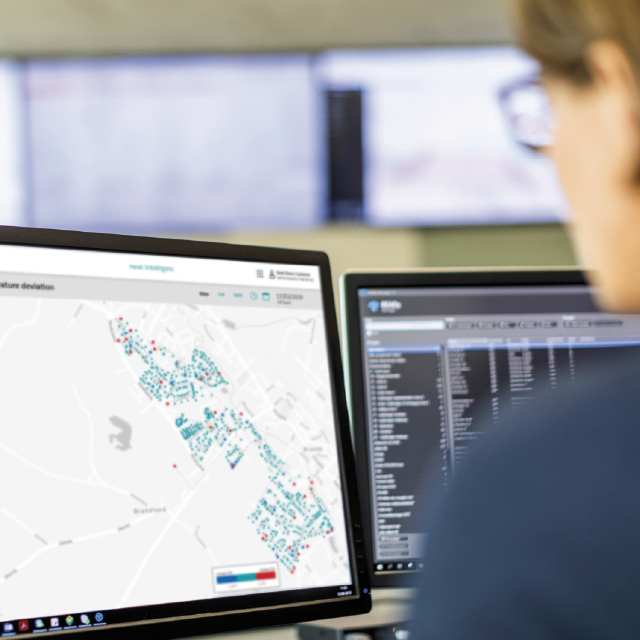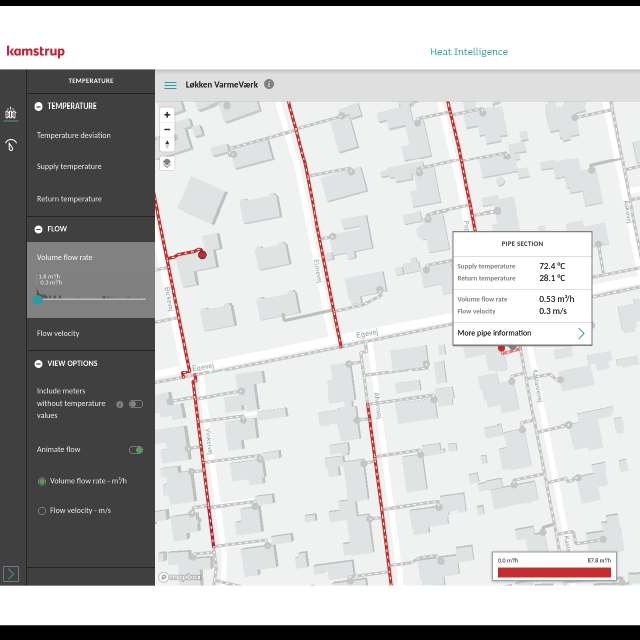
Heat Intelligence made Løkken Fjernvarme fully digital
Analytics, leak detection, pressure reduction
At Løkken Fjernvarme, they believe in steep learning curves and quick results. Network meter reading, new meters and new analysis software have thus already contributed to lower network pressure, effective leak detection and optimised pipe renovation since the utility now has the right foundation for making decisions.
When Løkken Fjernvarme began digging up the oldest pipes of the distribution network in 2016, Claus Christensen realised that many of them were actually in good order. The replacement, which was part of a long-term renovation plan, was therefore put on hold after a couple of years. ‘It was clear to us that we had to wait until we had the data to start renovating based on the pipes’ actual conditions.’
This data was obtained with new meters, network meter readings and the visualisation tool Heat Intelligence. The entire solution was implemented in less than a year in order to support the use of flexible tariffs and also to ensure a quick return on investment. ‘I would not get the full value of the solution until it was all up and running, so we had to move fast.’
New opportunities with network meter reading
Løkken Fjernvarme read the previous meters via drive-by, but they saw clear advantages in closer monitoring of the consumption. According to the Operations Manager, things therefore moved quickly after the utility was introduced to Heat Intelligence at a conference in 2019. ‘We chose Kamstrup due to Heat Intelligence and because the entire solution would then come from the same supplier, which specialised in meter data and the analysis of that data.’
Approximately every fourth home in the supply area is a holiday home, and this proportion is on the rise. This imposes special requirements on keeping the pipes warm, compared to all-year houses with a constant base load. In addition, the rental homes impose greater requirements for usable meter readings because a long time can pass before potential damage is discovered. ‘You’ll quickly notice damage in your home, but in a holiday home, they’ll call in March and say that something has been wrong since October. That’s one reason we chose network meter reading, so as to get data we can act on quickly,’ says Claus Christensen.
In November 2020, he therefore started learning to use Heat Intelligence. ‘Training is great, but I prefer to be hands on and learn it myself. It’s been a steep learning curve, but the quick results come when you take ownership of your own solution – and that’s the best advice I can offer others.’
The Operations Manager is very happy with the collaboration with Kamstrup throughout the process. ‘We only managed one physical meeting before Corona, so the rest has been virtual, but it’s been going very well. There are always some minor issues when you start something new, but they responded almost instantly.’

Heat Intelligence found the first leak within 24 hours
The day after Heat Intelligence was set up, Løkken Fjernvarme became aware of an increased water loss in the distribution network, and the extent indicated a large leak or pipe rupture. ‘Previously, we would drive out to look for steamy windows or surface water, but I thought we should be able to use Heat Intelligence.’
Claus Christensen began by looking at data from the date before the leak and set the volume filter to 0.3 – 1.3 m3/hour. When he looked at data from the following day, a specific service connection showed a much higher flow than the expected consumption for this type of user. At the address, it turned out that a pipe had burst in a living room, and the leak (of 600 m3/hour) was quickly repaired. ‘I used Heat Intelligence to determine where to look, and READy confirmed the flow. Today, Heat Intelligence is my preferred tool when we have leaks, and we have already discovered several.’
Noticeable optimisation of the distribution network
Soon after getting started with the new solution, Claus Christensen saw other tangible results from working with Heat Intelligence. Among other things, the utility has been able to lower the pressure in the network based on data from Heat Intelligence. ‘We have lowered the pressure in the network from 1.2 to 0.7 bar, and around 1 bar during periods of peak load. I think this saves us DKK 15-20,000 per year.’ The Operations Manager also uses Heat Intelligence to look at behaviour to determine when energy needs to be accumulated in the network in the morning. ‘Before, I used to work based on assumptions, but now I have a tool for the job.’
Løkken Fjernvarme has also used Heat Intelligence to attain a more balance flow in the two main pipes. Even though the town has grown, the utility has been setting up valves in the network the way it has always done. But, new information on the number of cubic metres moving around indicated that something was wrong. ‘When Heat Intelligence was up and running, we could see that the stress on the distribution network was very disproportionate. The distribution used to be 80/20, but now it is 50/50. This means less wear and stress on the pipes, but also significantly lower pressure, and therefore we use less energy and money to pump out the water.’
The benefits for Løkken Fjernvarme




‘Heat Intelligence is brilliant’
Heat Intelligence creates transparency in the network, which is valuable for to many of the tasks performed by Løkken Fjernvarme. ‘I think Heat Intelligence is brilliant. Particularly the combination of READy’s here-and-now-display with Heat Intelligence, which takes a historic look, visualises development and offers lots of insight – regardless of whether I am drawing data for troubleshooting, leak detection or maintenance.’ Claus Christensen expects that the tool can optimise renovation of the utility's distribution network – particularly the service connections. ‘We are owned by the users, so we are always focused on sustainability in our economy and on using money were it generates the most value – and this is something Heat Intelligence helps us do.’
According to the Operations Manager, the annual software licence is quickly recuperated on the optimisations and savings that the utility benefits from thanks to Heat Intelligence. ‘The 5% of my working hours that were previously spent on reading can now be used on activities that generate more value.’ He also describes the utility’s decision-making basis today as being entirely different than an annual snapshot from a modelling tool, which is what they previously relied on. ‘Today, a full overview is available online 365 days a year. And I can go back and examine a specific development and learn from it. That is a huge benefit.’

Facts about the project:
- Approx. 1,150 metering points (of these, approx. 300 summer cottages)
- 41 km distribution network (of this 16 km branch pipes)
- MULTICAL® 403 and 603 heat meters
- READy network reading Heat Intelligence








